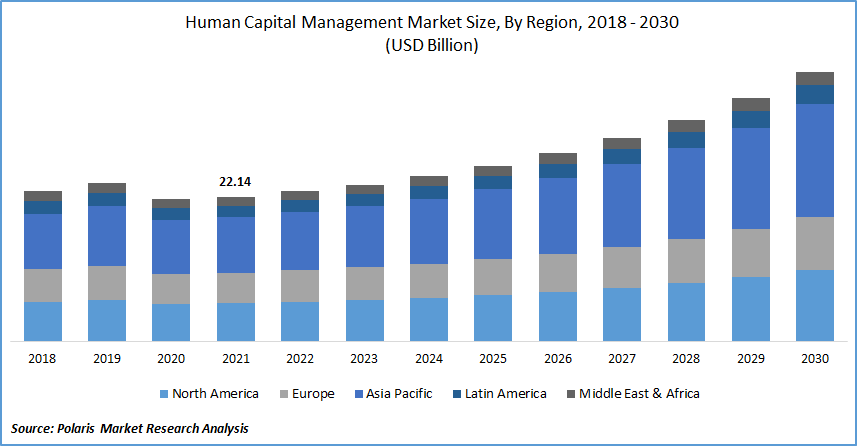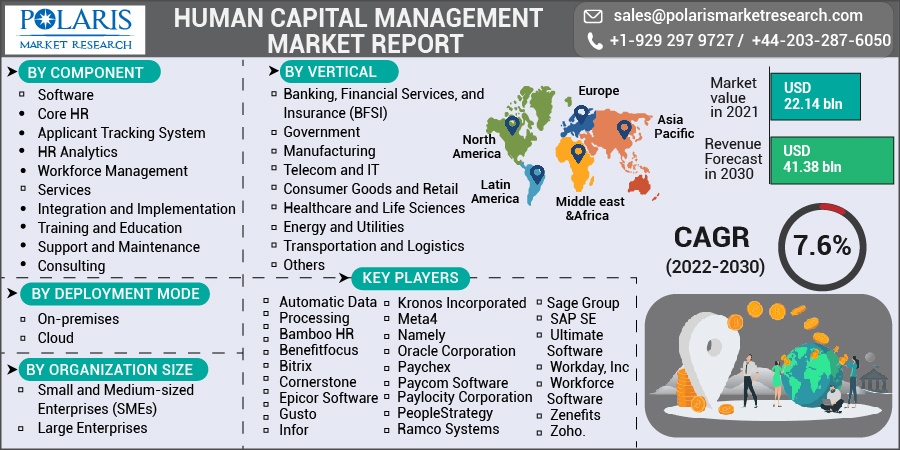
Human Capital Management Market Share, Size, Trends, Industry Analysis Report, By Component (Software, Services); By Deployment Model (On-premises, Cloud); By Organization Size; By Vertical; By Region; Segment Forecast, 2022 - 2030
- Published Date:Jun-2022
- Pages: 114
- Format: PDF
- Report ID: PM2442
- Base Year: 2021
- Historical Data: 2018 - 2020
Report Outlook
The global human capital management market was valued at USD 22.14 billion in 2021 and is expected to grow at a CAGR of 7.6% during the forecast period. One of the significant factors designed to encourage businesses to use human capital management solutions is digitizing business operations. These solutions reduce the manual labor required to complete time-consuming tasks in the human resources (HR) department. Also, due to the presence of so many players, the human capital management sector is highly competitive and highly fragmented.
 Know more about this report: Request for sample pages
Know more about this report: Request for sample pages
Dominant players frequently use a mergers and acquisitions strategy, expanding product lines and expanding their offerings. For instance, in September 2021, Workday, Inc announced that Google LLC had signed to Workday Adaptive Planning, Extend, Prism Analytics, and Strategic Sourcing to assist its employee base. It will also enlarge its existing use of Workday human capital management as part of the ongoing investment in talent management, introducing additional applications to deliver improved staff experiences and hiring to assist its global workforce.
Furthermore, significant growth in the e-commerce sector is driving up demand for HCM software to drive employee engagement value. Due to the increased COVID-19 pandemic, businesses worldwide have adopted a remote work culture, posing new challenges for HCM software and service providers. The major challenge is keeping offerings up to date with changing organizational cultures. This is projected to increase the uptake of human capital management software. However, enterprises' cutting costs and project delays may limit the adoption of human capital management software.
Industry Dynamics
Growth Drivers
Important factors such as adopting technological innovations, such as AI and ML, with HCM software, have emerged as one of the most potent factors influencing human capital management software and its advantages across regions. Most businesses across market sectors face a shortage of highly skilled workers as business operations become more complex as new technologies and innovations are adopted. As a result, HR managers worldwide are having difficulty hiring the right people for the right jobs. AI and ML can automate and streamline the recruitment process and provide filters to find the right person.
Furthermore, businesses worldwide embrace digitalization and the latest technologies such as AI, ML, and IoT. These technologies generate massive amounts of data in various formats. In March 2021, Zellis launched Zellis HCM Cloud, its flagship HCM solution. The new system includes the most recent cloud, automation, and AI developments to provide engaging employee experiences, empower businesses with transformative data analytics, and open incredible payroll and HR procedures efficiencies.
Zellis HCM Cloud can be implemented as a standalone, greatest payroll offering, integrated with a current HR system, or a complete complement that addresses all payroll and HR needs, "from hire to retire," in a solitary, highly expandable platform. This digital storefront allows consumers to conveniently access additional Zellis alternatives and connectors to third-party applications, allowing them to build their human capital management ecosystem.

Know more about this report: Request for sample pages
Report Segmentation
The market is primarily segmented based on component, deployment mode, organization size, vertical, and region.
|
By Component |
By Deployment Mode |
By Organization Size |
By Vertical |
By Region |
|
|
|
|
|
Know more about this report: Request for sample pages
Insight by Vertical
Based on the vertical segment, the BFSI segment is expected to be the most significant revenue contributor in the global market. The vertical has primarily used human capital management software to create a centralized system for managing the information of all employees, resulting in efficient coordination and improved performance, particularly during pandemic outbreaks. Advanced technologies and various software and services can assist this vertical in prioritizing its actions and managing its workforce efficiently.
Based on the organization size, SMEs will hold the highest share. Large enterprises have traditionally deployed human capital management software. However, this trend has now shifted to SMEs. It is anticipated to be there within the next five years, with SMEs contributing the most to the HCM market. Some of the factors responsible for this rapid growth include the growing need to manage a diverse workforce, enhance productivity, and comply with regulations. SMEs are dispersed geographically, necessitating a centralized system to manage this data.
Geographic Overview
In terms of geography, North America had the largest human capital management market revenue share. The region's market expansion can be attributed to ongoing technological advancement. Increased globalization and better work culture will positively impact North American growth.
Rapid advances in artificial intelligence (AI) and information technology (IT) are also required to contribute to the expansion of the North American HCM market. Another component expected to drive demand for human capital management market is the investigation of efforts and aggressive investment opportunities in digitizing human capital resource processes to improve organizational productivity. The growth principally for HCM solutions delivered through a Software as a Service (SaaS) delivery model is expected to fuel the development of the market.
Moreover, Asia Pacific is expected to witness a high CAGR in the global human capital management market. Large numbers of HCM vendors and the rising usage of cloud-native technologies drive growth in the region. The major countries are witnessing massive investments in market verticals such as BFSI, retail, healthcare, manufacturing, telecommunication services, and IT, resulting in Asia countries' economic growth. The market in the Asia Pacific is expected to be driven by organizations' increasing adoption of industry 4.0, data analytics, and cloud computing.
Competitive Insight
Major market players operating in the global human capital management market include Automatic Data Processing, Bamboo HR, Benefitfocus, Bitrix, Cornerstone, Epicor Software, Gusto, Infor, Ultimate Kronos Group, Meta4, Namely, Oracle Corporation, Paychex, Paycom Software, Paylocity Corporation, PeopleStrategy, Ramco Systems, Sage Group, SAP SE, Workday, Inc, Workforce Software, Zenefits, and Zoho.
Human Capital Management Market Report Scope
|
Report Attributes |
Details |
|
Market size value in 2021 |
USD 22.14 Billion |
|
Revenue forecast in 2030 |
USD 41.38 Billion |
|
CAGR |
7.6% from 2022 - 2030 |
|
Base year |
2021 |
|
Historical data |
2018 - 2020 |
|
Forecast period |
2022 - 2030 |
|
Quantitative units |
Revenue in USD million and CAGR from 2022 to 2030 |
|
Segments covered |
By Component, By Deployment Mode, By Organization Size, By Vertical, By Region |
|
Regional scope |
North America, Europe, Asia Pacific, Latin America; Middle East & Africa |
|
Key Companies |
Automatic Data Processing, Bamboo HR, Benefitfocus, Bitrix, Cornerstone, Epicor Software, Gusto, Infor, Ultimate Kronos Group, Meta4, Namely, Oracle Corporation, Paychex, Paycom Software, Paylocity Corporation, PeopleStrategy, Ramco Systems, Sage Group, SAP SE, Workday, Inc, Workforce Software, Zenefits, and Zoho. |
